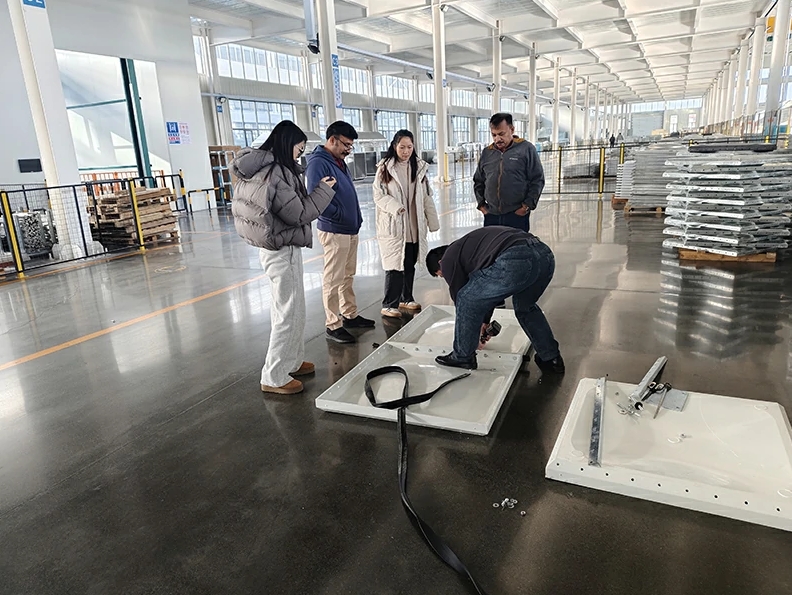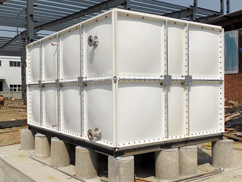Address: DeZhou,ShanDong,China | WhatsApp: +86-15098941090 | E-mail: support@aikegroupco.com

Recently, our company welcomed a group of important international visitors. This visit is not only an in-depth inspection of our company’s technical strength and product quality in the field of fan coil units, but also an important opportunity for both parties to deepen cooperation and seek common development.With the careful preparation and warm reception of the company’s leaders and technical team, the Singapore customer team first went deep into our company’s production workshop for a unique on-site visit. From the strict selection of raw materials to the fine polishing of finished products, every process demonstrates our company’s unremitting pursuit of quality.At the fan coil unit manufacturing site, the customer team showed great interest in our company’s rigorous production process and high-standard quality control system. They carefully inquired about each link in the production process and spoke highly of our company’s pursuit of excellence in detail control.As a professional manufacturer of fan coil products, our company has been working hard in technological innovation and product research and development . This time, the Singapore customer team expressed great appreciation for our company’s technical advantages in energy saving, environmental protection, low noise and high efficiency.“We attach great importance to our cooperation with your company. This on-site visit makes us more convinced that your products and technologies can fully meet our high standards.” The person in charge of the Singapore customer said sincerely after the visit. They gave special recognition to the high-efficiency performance and energy-saving effect of our company’s fan coil products, believing that this will bring them significant competitive advantages in future projects.This inspection not only deepened the understanding and trust between the two parties, but also laid a solid foundation for future cooperation. During the technical exchange session, the two parties conducted in-depth discussions on the latest technological developments and market trends in the field of fan coil units and reached a number of consensuses.In the future, our company and Singaporean customers will further strengthen technical exchanges and cooperation in the field of fan coil units and jointly promote product research and development and innovation. At the same time, the two sides will also work together to expand the international market and enhance brand influence through technology sharing and market collaboration.The visit of Singaporean customers is an important step in our company’s internationalization strategy, marking a new stage in the cooperation between the two sides. Looking to the future, we will continue to uphold the concept of innovation and quality, continuously improve the technical level and product quality, and provide more efficient, energy-saving and environmentally friendly air-conditioning equipment solutions for global customers.We believe that with the joint efforts of both parties, future cooperation will be more extensive and in-depth, and we will jointly create a better tomorrow. This inspection activity is not only a successful business exchange, but also an important milestone in our company’s journey towards globalization.

On November 27, 2024, Shandong Aike Holding Group Co., Ltd. welcomed an important customer delegation from Dubai. This visit not only deepened the understanding of each other between the two parties, but also opened a new chapter for our company’s cooperation in FRP water tank products in the international market.The visiting Dubai customers showed great interest in the technical strength and high-quality products of our company’s FRP water tank products. Through the on-site inspection, the customer team fully understood the design concept, production process and quality control system of our company’s FRP water tank.Accompanied by the management, the customer team visited the company’s production workshop, laboratory and R&D center. The on-site staff showed the customers in detail the production process, key technologies and quality inspection links of FRP water tanks, especially the company’s unique advantages in material selection, product design, anti-corrosion and pressure resistance. These displays won unanimous praise from customers and further deepened the trust between the two parties.As an enterprise in the FRP water tank industry, our company has made remarkable achievements in product performance, stability and environmental protection with years of technical accumulation and R&D innovation. During the inspection, Dubai customers expressed their technical recognition of the excellent performance of our company’s FRP water tanks in terms of corrosion resistance, high temperature resistance, and earthquake resistance.After the visit, the customer representative said: “We are very happy to visit your company in person and see your advanced production technology and high-quality products, which makes us more confident in the potential of cooperation between the two sides. We are deeply impressed by the innovative design and high efficiency and durability of your FRP water tanks. I believe this will be of great benefit to our future projects.”This inspection not only strengthened the understanding of the two sides, but also laid a solid foundation for future cooperation. The two parties reached a preliminary consensus on future cooperation in the field of FRP water tanks and discussed the promotion plan in Dubai and the Middle East market.Through continuous technical exchanges and cooperation, it is expected that the two parties will work together to promote the further popularization and application of FRP water tank products in the international market. In addition, the two parties also expressed that they will strengthen cooperation in product research and development and market development to jointly promote the innovation and development of FRP water tank technology.Shandong Aike Holding Group will continue to use its technical advantages in the field of FRP water tanks to help Dubai customers build projects in the Middle East, while further expanding the company’s influence in the global market. Both parties will uphold the concept of win-win cooperation and jointly create a more brilliant future.The visit of Dubai customers marks a solid step for Shandong Aike Holding Group in the international market. Through in-depth exchanges and cooperation between the two sides, we not only demonstrated the company’s superb technology in the field of FRP water tank products, but also opened a new door for future cooperation.Looking forward to the future, Shandong Aike Holding Group will continue to uphold the development concept of “quality first, innovation-driven, service first”, and strive to provide customers with more advanced, environmentally friendly and efficient water treatment equipment and services. We look forward to working hand in hand with Dubai customers to jointly create a new chapter in the international market for FRP water tank products!As a domestic research and development, production and sales enterprise of water tanks and related ventilation, fire protection, smoke exhaust, central air conditioning and other products, Shandong Aike Holding Group Co., Ltd. has been committed to providing global customers with high-quality fire protection and living water tank solutions. In the future, Aike Holding Group will continue to promote its internationalization strategy, continuously improve its technical strength and market competitiveness, and provide global customers with better products and services.

Time flies, the years are like a shuttle, the pace of time is hurried, leading to the change of sun and moon, the alternation of seasons, 2024 is coming to an end, and the Aike Group also ushered in its tenth birthday in this late winter December. Ten years, 3650 days of sunrise and sunset; ten years, 120 months of star shifting, Looking back on Aike’s ten years of ups and downs, there are laughter, tears, sweat, and harvest. Time has witnessed Aike’s growth,It also foresees Aike’s glory. On this occasion of celebration, all employees of the Aike Group gathered together to offer their congratulations and blessings to Aike on its tenth anniversary. Aike is a boat, and it has been surging for ten years, and its original intention has not changed; talents are sails, and Jichangfeng breaks through the waves and creates brilliance again. A dance “Set Sail” wishes Aike a new decade, a new journey, and a cloud sail, sailing with the wind.

How to Properly Maintain and Care for a Drinking Water Tank? A water tank is an essential component of our daily lives, serving the purpose of storing and keeping water at a suitable temperature. However, many individuals lack sufficient knowledge regarding the safe operation, storage, and maintenance of these tanks, which are crucial for the storage and supply of drinking water. Neglecting proper cleaning of the tank can lead to significant health issues over time. It is vital to understand the regulations surrounding the upkeep, operation, and maintenance of water tanks, as well as to master effective cleaning techniques. Ensuring good water quality in these tanks is paramount for public health. It is our responsibility to ensure that drinking water remains clean, making it essential to maintain the water quality of the tank. This article will present a variety of straightforward and effective strategies to assist you in preserving and maintaining the water quality of your tank.Storage Guidelines for Water Tanks1. Access to the drinking water tank, the associated room, and the pump room must be secured with locks. A log should be maintained for the key, documenting the name, date, time, and purpose of access, along with the approver's name and approval time. Any lost keys must be reported promptly, and locks should be replaced if necessary.2. All entries and exits to the drinking water tank, its room, and the pump room must be logged, and unauthorized personnel should not be allowed access to these areas without permission.3. Any maintenance performed on the drinking water tank, its room, and the pump room must be meticulously documented, including entry and exit times, details of the maintenance or cleaning performed, the names of the licensor and operator, and the reason for the maintenance. These records should be retained for a minimum of three years.4. A comprehensive inventory of the drinking water tank, its room, and the pump room, along with their equipment, must be maintained and updated at least once a year. This inventory should include details on cleaning, maintenance, testing, and inspections.5-It is necessary to forfulate an emergency water supply plan for life water and carry out work responsibility based on preparation and exercise.Guidelines for Maintaining a Drinking Water Tank–Operational Regulations1. Installation LocationSelect a well-lit, ventilated, and dry area for the installation of the drinking water tank. The surrounding environment should be free from corrosive gases, dust, and other contaminants. Avoid placing the tank near open flames or in high-temperature areas, and ensure it is not exposed to direct sunlight, tilted, or compressed. The installation site should be moisture-free, and the tank must be positioned horizontally and stably.2. Safety ValveA safety valve is essential to prevent the tank from over-pressurizing or rupturing. Regular inspections and cleaning of the safety valve are necessary to prevent blockages.3. Inlet PipeThe inlet pipe should connect securely to the public water supply or the original tap water line, ensuring there are no leaks. Additionally, an adjustable check valve and a filter screen should be installed to protect the interior of the tank from contamination.4. Blowdown PipeThe blowdown pipe must be installed separately or isolated from other water lines to prevent cross-contamination. Regular cleaning of the blowdown pipe is required to maintain unobstructed discharge.5. Pipe ConnectionsAll pipe connections to the water tank must be secure and reliable, free from looseness or leaks, to prevent water wastage and environmental pollution.6. Cleaning and DisinfectionThe water tank should be cleaned annually to maintain hygiene. Begin by emptying the tank, followed by a thorough cleaning to eliminate dirt and sediment.2. Guidelines for Maintaining a Drinking Water Tank-Maintenance Regulations1. Inspect the Operating ValveRegular checks and cleaning of the vent hole in the water tank's operating valve are necessary to ensure it remains unobstructed.1. Regular InspectionsIt is essential to conduct regular inspections of the water tank, focusing on the condition of pipes and valves. Timely cleaning and replacement of any damaged components are crucial to prevent blockages and ensure proper operation. Checking for seals and leaks in the water tank is vital for maintaining water quality. Poor sealing and leaks can lead to contamination of the water and waste of resources. Regularly inspect the tank for leaks, particularly at connections and valves. If any leaks are detected, promptly replace or repair the seals to ensure the tank remains well-sealed.2. Thermal Insulation CareThe water tank requires proper insulation to prevent excessive heat buildup. Regular inspections of the insulation materials are necessary to identify and replace any damaged sections, ensuring the effectiveness of the insulation.3. Ensuring Water Quality Regular cleaning of the water tank is fundamental to maintaining water quality. Accumulated dirt and bacteria can significantly degrade the water quality. To prevent this buildup, it is advisable to clean the tank every three to six months, depending on usage and water quality. Begin the cleaning process by turning off the water supply and draining the tank. When cleaning, it is important to wear protective gear, such as gloves and masks, to avoid contact with cleaning agents or contaminants. Use an appropriate cleaner, such as bleach or a specialized tank cleaner, following the manufacturer's instructions. After cleaning, thoroughly rinse the tank with clean water to eliminate any residual cleaning agents. Ensure that the tank is entirely empty before proceeding to refill it with water. Additionally, maintaining a clean environment around the tank is crucial for preserving water quality. The cleanliness of the area surrounding the tank directly impacts the water's quality. First, ensure that the vicinity is devoid of debris, litter, and potential contaminants. Such materials can infiltrate the water tank, leading to a deterioration in water quality. Next, focus on the sanitation of the area around the tank. Regularly remove dirt and dust to prevent these particles from entering the tank. It is also essential to maintain hygiene in the surrounding environment to prevent harmful substances from contaminating the water source. To effectively keep and maintain a drinking water tank, it is vital to prioritize the safe usage of the tank as part of water quality management. Consider the following recommendations to ensure optimal water quality during tank usage. First, refrain from storing or treating water with harmful chemicals, as certain substances can negatively impact water quality. Therefore, it is important to be mindful of where and how these substances are stored. Second, routinely inspect the discharge and intake pipes of the water tank to confirm that they are functioning properly and remain unobstructed. Additionally, be aware that water temperature can promote bacterial growth, which may compromise water quality. When managing heating and insulation, ensure that the water temperature remains within a suitable range. 1. Consistent water quality testing is essential for ensuring optimal conditions in water tanks. Such testing allows for a better understanding of water quality and the early detection of potential issues. You can either engage professional services for water quality assessments or utilize testing equipment for self-evaluation. By conducting regular tests, you can implement necessary actions promptly to maintain high water quality standards. To ensure the proper upkeep of a drinking water tank, it is crucial to prioritize water quality. Regular cleaning of the tank, inspecting for leaks and structural integrity, maintaining a clean surrounding environment, using the tank responsibly, and performing routine water quality tests are all effective strategies. These straightforward yet impactful practices not only safeguard our health but also contribute to the conservation of water resources.